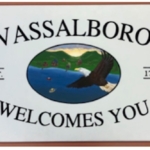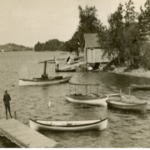Caron presentation at Vassalboro Historical Society
by Mary Grow
Historian Ray Caron’s illustrated talk on China Lake at the Vassalboro Historical Society Sunday afternoon, July 20, had his audience questioning, commenting and chuckling.
Caron, from Winslow, covered pieces of the history of the lake and its surroundings, including Winslow, from before the first Europeans arrived until the mid-20th century.
Caron said he has memories of China Lake from childhood, when his family visited his aunt and uncle on the northeast side of the east basin. He would sit on the dock and look across the water at “the scenic church,” China Baptist Church at the head of the east basin.
Long before Caron’s childhood, Native America tribes were familiar with China Lake. One of the assumed reminders of their visits is Indian Heart rock, on the southwest shore of the east basin, believed to be a Native carving.
Vassalboro Historical Society President Jan Clowes mentioned another rock on which the date 1850 is carved.
When Europeans settled this area in the second half of the 1600s, Caron said, streams, including China Lake’s Outlet Stream (then called Mile or Miles Brook), were vital sources of power for mills to grind grain and saw lumber. He showed a map of early Winslow mills on the brook.
Between 1675 and 1763, a series of wars between English settlers coming inland from the coast and would-be French influence from Canada decimated the Native Americans, Caron said. He cited one estimate that their numbers dropped from around 15,000 to around 4,000, mostly due to smallpox and other diseases the Europeans introduced.
Skipping to the years around 1900, Caron shared a variety of newspaper articles and other documents he had collected about China Lake and people who lived around it, including photographs of ice-cutting; information on the electric trolleys that brought visitors from Waterville and Augusta; and a reference to a boat trip to Abenaki Park, which neither he nor audience members could locate.
He also had information on proposed state water quality legislation, about 1909. John Woodsum, head of the China Lake Improvement Association, testified vehemently against it, on the ground that local people could protect their own water.
Vassalboro’s Albert Morris Bradley and his son, William Stickney Bradley, were credited with developing recreational facilities – dining room, bowling alley and dance hall – on Bradley’s Island, in the lake’s west basin, which they bought in 1876. Caron said they owned boats, including a 100-passenger sloop, to transport patrons to the island. He and audience members wondered which part(s) of the shore the boats lived on, and what passengers did during the ride to the island.
Bradley’s Island now belongs to the Town of China. Caron believes it was acquired for unpaid taxes.
The Bradleys also owned the Revere House, in East Vassalboro. Caron had photographs of A. M. Bradly, in his 90s, in the building. Clowes said a new owner is currently refurbishing the Revere House to eliminate lead.
The final stage in China Lake’s history that Caron covered was its use as Kennebec Water District’s water source for its customers in Waterville and surrounding towns.
Waterville’s drinking water used to come from Messalonskee Stream. That water was blamed for a 1906 typhoid epidemic that killed 40 people, leading to a search for a new source.
Messalonskee Lake might have been suitable, Caron said. He surmised China Lake was chosen because it is about 100 feet higher than Waterville, allowing gravity flow instead of pumping.
He showed numerous pictures of the job of laying miles of pipes in the early 1900s to bring the lake’s water north. Hundreds of Italian laborers from Massachusetts worked on the project. They were housed in 500-man camps; one photo caption referred to a “middle camp” in North Vassalboro and another to be built in East Vassalboro.
Caron currently heads the Friends of Fort Halifax, in Winslow. He showed pictures of the near-replica of one of Benedict Arnold’s bateaux the group has built in preparation for the 250th anniversary of Arnold’s expedition up the Kennebec to Québec, in September 1775.
Recently, he said, an excavation for a new stage in Fort Halifax Park unearthed what were determined to be Native American teeth. After identification and consultation with current Maine Native Americans, reburying them was found to be appropriate and was done.
Responsible journalism is hard work!
It is also expensive!
If you enjoy reading The Town Line and the good news we bring you each week, would you consider a donation to help us continue the work we’re doing?
The Town Line is a 501(c)(3) nonprofit private foundation, and all donations are tax deductible under the Internal Revenue Service code.
To help, please visit our online donation page or mail a check payable to The Town Line, PO Box 89, South China, ME 04358. Your contribution is appreciated!






Leave a Reply
Want to join the discussion?Feel free to contribute!